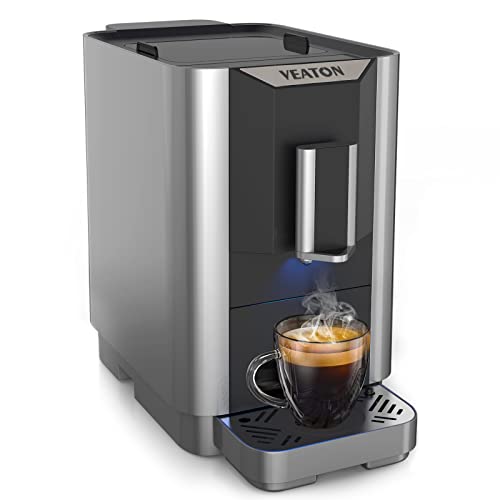How to Make Espresso Machine Coffee
Espresso machines can create an excellent cup of coffee, but they require more maintenance and setup than a typical coffee maker. It is also necessary to grind and tamp the beans by yourself.
The secret to making espresso is pressure. Here's how an espresso machine works: a heating vessel is used to heat water to a suitable temperature before forcing it through the grounds and out the spouts.
Temperature

Espresso is produced when hot water is forced under pressure through finely ground coffee. The temperature of the water is essential to the quality of the final shot. Temperatures that are too low can result in a lack of flavor compounds. The high temperatures can cause over extraction, which can cause bitter or burnt taste.
The ideal temperature range for espresso is 195-205degF. This temperature is achieved using an espresso group head that has been made to maintain consistency and stability throughout the brewing cycle. The most sought-after type of group head is the E61 that provides an array of temperature stability as well as pre-infusion capabilities and lever control.
It is essential to consider the temperature when you adjust your espresso machine to different roasts or brew ratios. This can affect the extraction yield and the crema. The optimal temperature will depend on the specific roast and bean however, the general rule is that lighter roasts and greater ratios of brews need higher temperatures than dark roasts and lower brew ratios. A high-quality thermocouple is vital to maintain the same temperature.
Pressure
In the process of brewing, espresso machine coffee is pushed under pressure through finely ground coffee grounds that have been put through a tamper. This triggers chemical reactions that extract flavors oils, flavors and other soluble elements from the beans. The resulting drink is usually more flavorful and richer than regular coffee.
The ideal espresso machine pressure should be nine bar that's equivalent to sea-level pressure. The soluble compounds present in the espresso bean are most effectively extracted at this pressure.
Some espresso machines advertise up to 20 bars of pressure. Although these machines can reach these pressure levels but they might not be capable of maintaining the pressure during the extraction.
One bar of pressure equals to 32 pounds per square inch (PSI) of a car's tire. It's also four times the pressure professional cyclists use when filling their bicycle tires. The ability to control the espresso machine's pressure and make consistent espressos is essential for any serious home barista.
Water
The water you use to make espresso is one of the most crucial elements of a great cup coffee. The correct water can help your beans to extract their full potential. However the wrong type of water could cause problems such as clogged pipes and damage to your expensive machine.
The best choice is a natural spring water that is rich in minerals to ensure optimum espresso extraction. This water will enhance the flavor of your espresso without the chalky mineral trace that comes from tap water or bottled water. This is an excellent alternative to distilled or reverse osmosis, which is often too pure and cause problems with flavor.
However, you should not use filters that remove excessive minerals from your tap water, as this can also cause flavor and extraction issues. Buy a water testing kit to determine the average hardness of your local water. This information can be used to determine the correct filtration system to your espresso machine.
Beans
Most coffee aficionados tend to get very involved with the whole process of making espresso. They get obsessed about a range of variables, such as temperature, water pressure, and viscosity. If one of the variables is not in order the whole shot could taste bad.
The beans used are the most important element when it comes down to espresso. Many people believe that only certain kinds of beans are suitable for espresso. While some beans are better suited for certain purposes however, any bean that has been roasted can be used to make espresso. machines espresso between espresso beans and regular coffee beans is that espresso beans are roast for longer and tipycally over the second crack and give them an appearance darker and makes them more water-soluble.
Medium or dark-roasted beans are the best choice for espresso because they give espresso shots a richness and a boldness. Light roasted beans can also be used to make great espresso, especially when they're pre-ground for ease of use in an espresso maker.
Milk
Espresso and milk are a classic combination. The coffee doesn't just boost energy levels, but the steamed milk helps balance the bitterness of espresso, and gives it a delightful creaminess. There aren't many culinary combinations better than this one!
If you decide to purchase an espresso machine that can make cappuccino or lattes take a consider how easy it is to use. A lot of the top espresso machines have a jug that can be filled with cold or hot milk along with a steam wand as well as a portafilter for pulling the shot. Some models include an inbuilt grinder, tamper, and frother.
The steam wand needs to be purged before using it for the first time every day (or after every cup of espresso) to eliminate any water that has condensed. The process takes only 30 seconds, but is essential to keep your machine running smoothly. If you don't flush this process, it could lead to bitterness and/or a buildup of bacteria which can alter the flavor or aroma of your beverage. It's simple to do and should be part of your routine maintenance.
